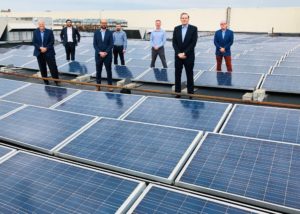Many of the flex/industrial buildings in Robert Martin Co.’s (RMC) real estate portfolio of some 6 million square feet will soon be sporting solar panels.

The company is embarking on a program with Manhattan-based G&S Solar and the nonprofit Sustainable Westchester. RMC, which is headquartered in Elmsford, owns and manages more than 60 office, industrial, multifamily, and retail properties in Westchester and Fairfield counties.
Jeremy Frank, RMC”™s vice president for investment, told the Business Journal that when all of the solar installations have been completed in the next year or two, more than 10 megawatts of electricity — enough to power about 1,700 homes — will be generated at RMC’s sites for the electric grid.
“Con Edison sort of runs the timeline because they need to figure out the engineering for the interconnect to the electric grid for each different solar installation, so we have applications in on the majority of our buildings,” Frank said. “As Con Ed figures out the interconnections, we”™ll roll them out on an ongoing basis.”
Initial solar projects include installations at RMC”™s 1.3 million-square-feet Cross-Westchester Executive Park in Elmsford and 770,000-square-feet Mid-Westchester Executive Park in Hawthorne.
G&S Solar, founded in 2009, had its roots with G&S Investors, which began in 1982 as a real estate developer. It began installing solar arrays at its own properties and expanded from there.
It has built more than 160 solar projects in New York, New Jersey and Massachusetts. It has various business models for installation, operation and maintenance of solar arrays that can include leasing space on rooftops, in parking lots or on undeveloped land. Revenue streams come from the electricity generated by the installations.
Sustainable Westchester is a nonprofit consortium of Westchester County local governments that has been bringing electricity from renewable sources into their communities. It is active in marketing solar projects to local residents and small businesses owners who are interested in saving money by purchasing solar-generated electricity within their utility service territory.
“We”™re signing leases where the solar developer leases the rooftop space from us and they pay for the majority of the costs of the solar installations,” Frank said. “We”™re happy to be able to market our buildings as environmentally efficient. The electricity gets pushed back into the grid. It”™s not necessary that the tenants in the building are directly using the electricity, although they do have that option.”
Frank said that everyone at RMC has been enthusiastic about moving forward with the solar program to contribute toward sustainable energy production.
“We”™ve seen other buildings in the greater New York tri-state area, mostly industrial buildings, take advantage of unused roof space to generate solar electricity,” Frank said. “I don”™t think it”™s something that”™s limited to other geographies or locations. Actually, when we bought the portfolio from Mack Cali we already had this in mind and we met with several national solar developers and then finally zeroed in on a couple of them and selected G&S.”
RMC”™s CEO Tim Jones said: “Tackling climate change globally will require rethinking locally how, when and where we generate and distribute energy. It”™s an ambitious undertaking, but for the past 60 years, the company”™s formula for success has been putting the needs of the community first, knowing that the financial success will follow.”
In another energy program, RMC recently completed the replacement of more than 3,100 exterior and interior light fixtures across its portfolio with new energy-efficient LED fixtures. The company estimates the new fixtures will save more than 1.2 million kilowatt hours of electricity per year, which translates to an annual energy cost savings to the company of approximately $240,000.



















